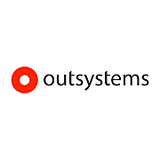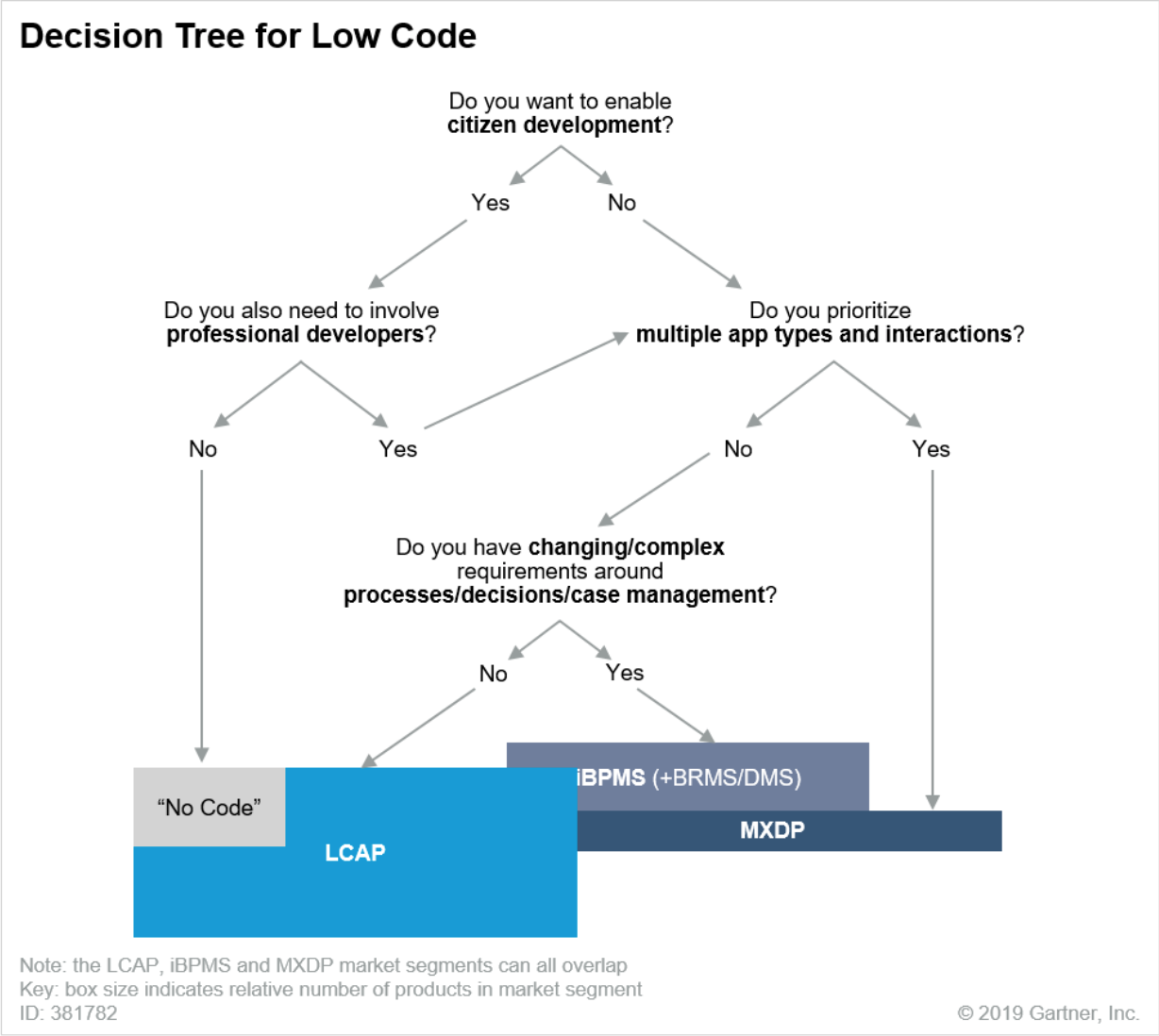Low code / No code development platform
Low-code development is a visual -drag-and-drop- development approach that facilitates the delivery of applications by reducing hand-coding as much as possible +Show More
| Products | Position | Customer satisfaction | |||
|---|---|---|---|---|---|
|
|
Niche Player
|
Satisfactory
|
|||
|
Studio Creatio is a no-code platform with composable architecture to automate workflows and build applications with maximum degree of freedom. It combines a range of no-code tools that enable users to create powerful business applications in hours and minutes instead of weeks. Thanks to its focus on drag-and-drop development tools, even users without deep technical skills can successfully implement business applications, automated workflows, ML/AI-powered models for data-backed decision making, and business rules.
Studio Creatio offers one environment for workflow development, automation, and orchestration. You can create your own process templates, utilize workflow automation solutions from Creatio marketplace, and connect multiple departments, systems, and data stores into a unified digital ecosystem.
Studio Creatio provides extensive integration capabilities (.Net tools, REST, SOAP, OData, open API), advanced identity and access management, and flexible organization structure management, all of which ensure swift integration of Creatio into the software ecosystem of any company.
Basis for EvaluationWe made these evaluations based on the following parameters; Customer satisfaction
Average rating
Market presence
Company's number of employees
400-1k employees
Company's social media followers
100k-1m followers
Total funding
$50-100m
# of funding rounds
1
Latest funding date
February 22, 2021
Last funding amount
$50-100m
Company
Type of company
private
Founding year
2014
|
|||||
|
|
Challenger
|
Satisfactory
|
|||
|
Simple workflow software for businesses. Create recurring checklists, workflows and standard operating procedures in seconds.
Basis for EvaluationWe made these evaluations based on the following parameters; Customer satisfaction
Average rating
Market presence
Company's number of employees
50-100 employees
Company's social media followers
30k-40k followers
Total funding
$10-50m
# of funding rounds
5
Latest funding date
February 27, 2020
Last funding amount
$10-50m
Company
Type of company
private
Founding year
2014
|
|||||
|
|
Leader
|
Satisfactory
|
|
||
|
monday.com Work OS is a customizable platform where teams create their own applications, project management solutions and collaborate across departments. More than 180,000 customers worldwide use monday.com.
With easy-to-use building blocks like dashboards, automations, and integrations, teams are empowered to build their ideal workflow in one intuitive workspace.
Industry-specific products like monday work management, monday sales CRM and monday dev, organizations can build solutions tailored to their use cases and team sizes.
You can get the 14-day free trial to find out how monday.com can help your team.
Basis for EvaluationWe made these evaluations based on the following parameters; Customer satisfaction
Average rating
Market presence
Number of case studies
100-200 case studies
Company's number of employees
2k-3k employees
Company's social media followers
100k-1m followers
Total funding
$250-500m
# of funding rounds
8
Latest funding date
June 10, 2021
Last funding amount
$100-250m
Company
Type of company
public
Founding year
2012
|
|||||
|
|
Leader
|
Satisfactory
|
|
||
|
Airtable is a platform that combines elements of a spreadsheet with a database, allowing users to organize, collaborate on, and manage data in a versatile and visual way, catering to various organizational and project management needs.
Basis for EvaluationWe made these evaluations based on the following parameters; Customer satisfaction
Average rating
Market presence
Number of case studies
50-100 case studies
Company's number of employees
400-1k employees
Company's social media followers
100k-1m followers
Total funding
$1-5bn
# of funding rounds
11
Latest funding date
July 1, 2022
Company
Type of company
private
Founding year
2013
|
|||||
|
|
Leader
|
Satisfactory
|
|
||
|
No-code solutions to start, run and grow your business in a well-rounded manner. Get started with Appy Pie's no-code mobile app builder (https://www.appypie.com/app-builder), no-code website builder (https://www.appypie.com/website-builder), no-code chatbot builder (https://www.appypie.com/chatbot/builder) or no-code workflow automation builder (https://www.appypie.com/connect/).
Basis for EvaluationWe made these evaluations based on the following parameters; Customer satisfaction
Average rating
Market presence
Number of case studies
10-20 case studies
Company's social media followers
40-50 followers
|
|||||
|
|
Leader
|
Satisfactory
|
|
||
Basis for EvaluationWe made these evaluations based on the following parameters; Customer satisfaction
Average rating
Market presence
Number of case studies
10-20 case studies
Company's number of employees
400-1k employees
Company's social media followers
100k-1m followers
Total funding
$1-5m
# of funding rounds
1
Latest funding date
April 2, 2019
Last funding amount
$1-5m
Company
Type of company
private
Founding year
2017
|
|||||
|
|
Leader
|
Satisfactory
|
|
||
|
OutSystems offers a low-code platform for building customer apps and portals, internal business apps, core systems, etc.
Basis for EvaluationWe made these evaluations based on the following parameters; Customer satisfaction
Average rating
Market presence
Number of case studies
200-300 case studies
Company's number of employees
2k-3k employees
Company's social media followers
100k-1m followers
Total funding
$1-1bn
# of funding rounds
8
Latest funding date
October 15, 2022
Last funding amount
$100-250m
Company
Type of company
private
Founding year
2001
|
|||||
|
|
Challenger
|
Satisfactory
|
|
||
|
Quickbase offers a no-code platform to assign tasks, automate workflows, and generate insightful reports.
Basis for EvaluationWe made these evaluations based on the following parameters; Customer satisfaction
Average rating
Market presence
Company's number of employees
400-1k employees
Company's social media followers
20k-30k followers
Total funding
$50-100m
# of funding rounds
2
Latest funding date
December 17, 2019
Last funding amount
$50-100m
Company
Type of company
private
Founding year
1999
|
|||||
|
|
Challenger
|
Satisfactory
|
|
||
|
AppSheet is the intelligent no-code platform trusted by over 200,000 app creators around the world including Clearlink, Enterprise Holdings, ESPN, Pepsi, Husqvarna and more. A Forrester Low/No Code Development Platform leader in 2018. Build a No Code App in 4 Ways: 1) Connect your data sources (e.g. Excel, Google Sheets, SQL, etc.) 2) Copy a sample app. 3) Use an Add-On for Google Sheets, Forms, or Excel. 4) Start from SPEC, our natural language declarative programming tool.
Basis for EvaluationWe made these evaluations based on the following parameters; Customer satisfaction
Average rating
Market presence
Number of case studies
50-100 case studies
Company's number of employees
20-30 employees
Company's social media followers
10k-20k followers
Total funding
$10-50m
# of funding rounds
6
Latest funding date
April 25, 2019
Last funding amount
$10-50m
Company
Type of company
private
Founding year
2012
|
|||||
|
|
Challenger
|
Satisfactory
|
|
||
|
Salesforce Platform is the leading low-code development platform that empowers your team to build and extend your Customer 360 with AI, automation, and data. With the Salesforce Platform, you can execute on your Customer 360 vision, securely, and keep your customer at the center of everything you do. Access a harmonized, unified view of your customers, automate manual, inefficient processes to drive productivity, and empower your employees to deliver a seamless, connected customer experience. Accelerate your Salesforce development, increase developer efficiency, and save on IT costs with the Salesforce platform.
Basis for EvaluationWe made these evaluations based on the following parameters; Customer satisfaction
Average rating
Market presence
Number of case studies
10-20 case studies
Company's number of employees
5-10 employees
Company's social media followers
5k-10k followers
Total funding
$50-100m
# of funding rounds
7
Latest funding date
October 18, 2022
Company
Type of company
public
Founding year
1999
|
|||||
“-”: AIMultiple team has not yet verified that vendor provides the specified feature. AIMultiple team focuses on feature verification for top 10 vendors.
Sources
AIMultiple uses these data sources for ranking solutions and awarding badges in low code / no code development platforms:
Low code / No code development Leaders
According to the weighted combination of 4 metrics





What are low code / no code development
customer satisfaction leaders?
Taking into account the latest metrics outlined below, these are the current low code / no code development customer satisfaction leaders:





Which low code / no code development solution provides the most customer satisfaction?
AIMultiple uses product and service reviews from multiple review platforms in determining customer satisfaction.
While deciding a product's level of customer satisfaction, AIMultiple takes into account its number of reviews, how reviewers rate it and the recency of reviews.
- Number of reviews is important because it is easier to get a small number of high ratings than a high number of them.
- Recency is important as products are always evolving.
- Reviews older than 5 years are not taken into consideration
- older than 12 months have reduced impact in average ratings in line with their date of publishing.
What are low code / no code development
market leaders?
Taking into account the latest metrics outlined below, these are the current low code / no code development market leaders:





Which one has collected the most reviews?
AIMultiple uses multiple datapoints in identifying market leaders:
- Product line revenue (when available)
- Number of reviews
- Number of case studies
- Number and experience of employees
- Social media presence and engagement
What are the most mature low code / no code development platforms?
Which one has the most employees?





Which low code / no code development companies have the most employees?
47 employees work for a typical company in this solution category which is 24 more than the number of employees for a typical company in the average solution category.
In most cases, companies need at least 10 employees to serve other businesses with a proven tech product or service. 161 companies with >10 employees are offering low code / no code development platforms. Top 3 products are developed by companies with a total of 800k employees. The largest company in this domain is IBM with more than 300,000 employees. IBM provides the low code / no code development solution: IBM Domino
Insights
What are the most common words describing low code / no code development platforms?
This data is collected from customer reviews for all low code / no code development companies. The most positive word describing low code / no code development platforms is “Easy to use” that is used in 12% of the reviews. The most negative one is “Difficult” with which is used in 3% of all the low code / no code development reviews.
What is the average customer size?
According to customer reviews, most common company size for low code / no code development customers is 1-50 Employees. Customers with 1-50 Employees make up 52% of low code / no code development customers. For an average Software Development solution, customers with 1-50 Employees make up 29% of total customers.
Customer Evaluation
These scores are the average scores collected from customer reviews for all low code / no code development platforms. Low code / No code development platforms are most positively evaluated in terms of "Overall" but falls behind in "Likelihood to Recommend".
Where are low code / no code development vendors' HQs located?
Trends
What is the level of interest in low code / no code development platforms?
This category was searched on average for 14k times per month on search engines in 2024. This number has decreased to 0 in 2025. If we compare with other software development solutions, a typical solution was searched 6k times in 2024 and this decreased to 0 in 2025.
Learn more about Low code / No code development platforms
Low-code and no-code development platforms help users design and build applications with minimal or no coding required. Low-code platforms are often used by professional developers to speed up the development process. No-code platforms are designed for for non-technical users.
The rise of citizen developers, better enterprise alignment and increasing productivity are leading to the growing importance of low-code development. You can find a more detailed explanation of this in our research section.
The business team uses visual building blocks to develop applications. Feel free to read our more detailed answer in our research section.
Here are a few questions you need to ask while choosing a low-code development platform:
Is it scalable?
Though the purpose of low-code development is mainly driven by developing relatively smaller and departmental applications, there are enterprise-wide LCDPs as well. As the number of users increases, being able to scale becomes a matter for a company. Therefore an organization should consider a scalable LCPD if they want to integrate low-code technology within the enterprise.
Does it have a no-code option?
Most low code platforms require some input codes for business logic and process flow descriptions that's why enterprises still need developers for low-code development. On the other hand, some platforms in the market have a no-code option which enables citizen developers to build applications with minimal involvement from the tech team.
Does it allow collaboration across business and IT teams?
Developing an application mostly needs teamwork. LCDPs enable users to interact with each other while they’re working on the application. Executives need to pay attention if the platform has collaborative working features.
Is it available on the cloud?
Some platforms took off as on-premise applications and have limited cloud support. It would be great to have a platform with cloud support since most organizations are either on the cloud or plan to be on the cloud soon.
Is it secure?
Security is an important concern for businesses from various industries. The right tool for businesses is the one that has all the required security certifications and is approved by your company's information security team
Usecases include:
- MVPs.
- Customer engagement apps
- Smart process apps
- Software modernization apps
You can find more on each use case on our low code research article.
Gartner identifies these different platforms that feature similar solutions to low-code development technologies. Each platform can meet the different needs of an enterprise. Below is their suggested decision tree for a procurement decision regarding an app development platform.
- Low-code application platforms(LCAPs) provide a graphical user interface development experience for citizen developers. LCAPs are a solution to the growing application demands from the business and IT budget-related problems.
- Multiexperience Development Platforms(MXDPs): Low-code development tools are also used in multiexperience development platforms. MXDPs use low-code development to increase the productivity of application development in different touchpoints such as web, mobile, wearables, chatbots, augmented reality (AR) and virtual reality (VR).
- Process and business rule/decision management systems (BRMS): A BRMS is a low-code technology platform that implements, manages and executes business logic and decision processes.
- No code development platforms: Platforms that enable citizen developers to code without using a programming language

Some key benefits of low-code/no-code development platforms include:
- Rapid development and deployment: Reduce the development process, allowing users to rapidly build and deploy applications.
- Accessibility: Easier for non-technical users to create applications.
- Scalability: Offer reusable components and templates.
Low-code and no-code platforms can be used for:
Managing and publishing digital content
Developing internal or customer-facing portals for various services
Creating apps that automate routine business processes
Creating visual dashboards to monitor KPIs










